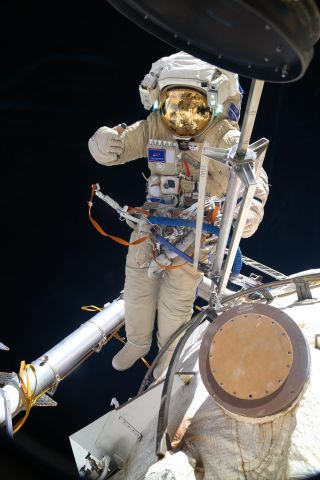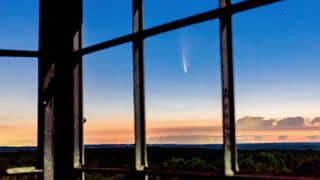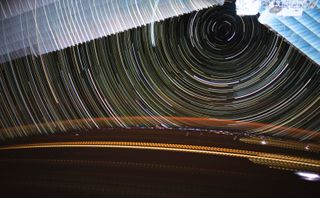Space pictures! See our space image of the day
National Space Day!
Space can be a wondrous place, and we've got the pictures to prove it! Take a look at our favorite space pictures here, and if you're wondering what happened to today in space history don't miss our On This Day in Space video show here!
National Space Day!

Friday, May 3, 2024: Happy National Space Day in the U.S.A.! Observed on the first Friday in May, National Space Day celebrates the accomplishments and benefits from history of spaceflight. The day is largely used to promote STEM (science, technology, engineering and math) education, and inspire people about the cosmos.
Here, ISS Expedition 71 cosmonaut Nikolai Chub gives a thumbs-up during a recent EVA. During Chub's four-hour and 36-minute spacewalk on April 25, he and fellow cosmonaut Oleg Kononenko deployed a synthetic radar communications system and installed experiments to monitor external station corrosion.
Sunrise from space

Thursday, May 2, 2024: The sun peaks through Earth's thin layer of atmosphere, captured here from the International Space Station (ISS). The ISS spans about the size of an American football field, and sits above the planet in low-Earth orbit, at an average altitude of 254 miles (408 kilometers). As a result of this orbit, astronauts aboard the space station are able to witness a sunrise like the one pictured here every 45 minutes.
As the sun rises from behind our home planet in this photo, the faint light of our star reflects off Northrup Grumman's NG-20 Cygnus spacecraft docked with the station. Cygnus launched to the ISS Jan. 30, delivering over 8,000 pounds (3,600 kilograms) of supplies and research equipment.
Barred Spiral Galaxy

Wednesday, May 1, 2024: A new image from the Hubble Space Telescope shows the barred spiral galaxy NGC 2217 (also known as AM 0619-271), swirling through space 65 million light-years away.
Called a "barred" galaxy because of the column of light reaching from opposite sides of the galactic center, these "bars" channel gasses from the galaxy's disk into its middle regions. These gasses then can form new stars, or serve as fuel for the galaxy's supermassive black hole. According to NASA, NGC 2217 is about the same size as our Milky Way galaxy, measuring roughly 100,000 light-years across, and can be found in the constellation of Canis Major.
Get the Space.com Newsletter
Breaking space news, the latest updates on rocket launches, skywatching events and more!
Archives
Check out our Image of the Day Archives for more awesome photos.
Image of the Day 2020 Archive

Image of the Day 2019 Archive

Can't find the date you're looking for? It may have been a weekend or holiday, when we don't normally update our Image of the Day.
Click 'NEXT PAGE' below for April >
Join our Space Forums to keep talking space on the latest missions, night sky and more! And if you have a news tip, correction or comment, let us know at: community@space.com.

Space.com is the premier source of space exploration, innovation and astronomy news, chronicling (and celebrating) humanity's ongoing expansion across the final frontier. Originally founded in 1999, Space.com is, and always has been, the passion of writers and editors who are space fans and also trained journalists. Our current news team consists of Editor-in-Chief Tariq Malik; Editor Hanneke Weitering, Senior Space Writer Mike Wall; Senior Writer Meghan Bartels; Senior Writer Chelsea Gohd, Senior Writer Tereza Pultarova and Staff Writer Alexander Cox, focusing on e-commerce. Senior Producer Steve Spaleta oversees our space videos, with Diana Whitcroft as our Social Media Editor.
-
rod ReplyThe Exoplanets Channel said:The images are truly breath-taking.
The Exoplanets Channel, what star and reddish exoplanet is shown in your picture, looks like about 8" angular separation? I use this site as my canonical reference to exoplanets, The Extrasolar Planets Encyclopaedia Currently 4150 exoplanets are listed. -
swiggly ReplyThe Exoplanets Channel said:The images are truly breath-taking.
My Comet Image:
Neowise -
rod Reply
This is a very good image here. In enjoyed some recent views of NEOWISE using my 90-mm telescope at 40x early, shortly after 0415 EDT. Bifurcated tail obvious too.swiggly said:My Comet Image:
Neowise -
Helio The IOD image for yesterday of the Veil nebula is stunning! The graphics are such that it's almost as if it has an oil film on top. It has both 3D and texture feel to it.Reply -
Astro.Letizia I hope they start posting these daily again! I always start my day off with the newest image but it's been a couple of months now :(Reply
